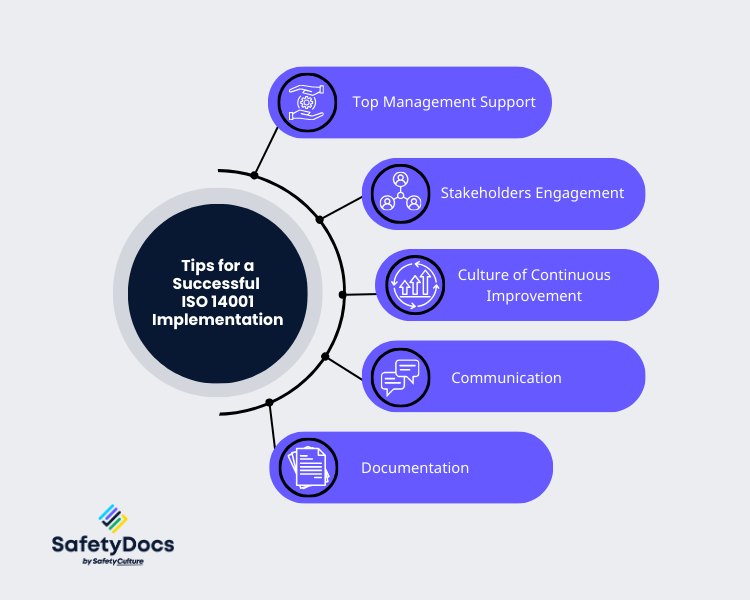ISO 14001 is a globally recognised environmental management system (EMS) standard. It offers a structured framework for organisations to follow best practices in controlling and mitigating their environmental impact. A 2019 study by the University of Tasmania explored the state of its implementation in Australia. The findings revealed that adopting ISO 14001 was still in its early stages. However, as of 2023, no statistical data is available to confirm improvements.
Although there has yet to be solid evidence of ISO 14001 implementation improvements in Australia, the standard remains significant. Its core elements are fundamental in ensuring organisations comply with its requirements and achieve the intended outcomes. This blog will delve deeper into these elements, their importance, and how they contribute to more sustainable business practices and environmental management.

Core Elements of ISO 14001 for Australian Businesses
Environmental Policy
The environmental policy serves as the foundation for the entire EMS, outlining the organisation's commitment to environmental responsibility. It sets the tone for a culture of sustainability and guides decision-making at all levels. An environmental policy outlines their commitment to sustainable development, compliance, pollution prevention, and continual improvement.
This policy must align with the organisation's goals and objectives, clearly state its purpose, and serve as a guide for all activities. Organisations must involve top management and ensure all employees communicate, understand, and enforce their policies to implement this.
Planning
Planning is a crucial stage, involving identifying environmental aspects and impacts, legal requirements, and risks associated with the organisation's operations that could significantly impact the environment. Through this process, organisations can set clear objectives and targets for environmental improvement.
Organisations can do this by establishing mechanisms for identifying risks associated with their activities, products, or services on the environment. They can use tools like environmental impact assessments to identify and evaluate these risks. A well-thought-out plan ensures systematic integration of environmental considerations into daily operations.
Implementation and Operation
Putting plans into action requires a coordinated effort. The implementation phase requires a collaborative effort, emphasising employee engagement and awareness. To ensure a thorough comprehension of the impact their actions have on the environment, it is imperative that employees undergo appropriate training.
Resource allocation is crucial in this stage, ensuring resources are available for implementing environmental management activities. Document control is also critical and includes creating procedures to keep track of documentation, such as manuals and records.
Monitoring and Measurement
Regular monitoring and measuring of environmental performance provide organisations with data to assess their progress. Key performance indicators (KPIs) help track performance and identify areas for improvement. This element is essential in evaluating the effectiveness of an environmental management system and meeting regulatory requirements.
The operation's key characteristics that significantly impact the environment shall be monitored and measured regularly. To monitor and measure, organisations must establish procedures for sampling and testing, tracking performance against KPIs, and conducting internal audits to verify compliance.
Checking and Corrective Action
The checking and corrective action phase involves reviewing and taking corrective actions when necessary to ensure continuous improvement. Organisations must regularly check their environmental performance, including the effectiveness of the environmental management system and the achievement of their environmental objectives and targets.
These reviews provide an opportunity for feedback from stakeholders, employees, and the public on an organisation's environmental impact. Based on this feedback, organisations can make adjustments to
Management or Leadership Review
Senior management must review the organisation's environmental performance regularly. This top management review includes evaluating the effectiveness of the environmental management system in meeting objectives and targets, identifying areas for improvement, and making necessary adjustments to policies and procedures. This ensures the continuing suitability, adequacy, and effectiveness of EMS.
Continuous Improvement
ISO 14001 is a continuous improvement process, with organisations expected to continually review and improve their environmental performance. This includes setting new targets and objectives based on changes in organisational operations, technology, or environmental management.
Continual improvement ensures that organisations meet regulatory requirements, changing stakeholder expectations and societal needs while striving towards sustainable development.

Importance of ISO 14001 Elements
These core elements collectively contribute to the success of ISO 14001 in several ways:
1. Compliance
ISO 14001 is not mandatory, but its principles are often integrated into environmental regulations, encouraging voluntary adoption. By complying with the standard, organisations demonstrate their commitment to environmental management and avoid potential legal consequences.
When these elements are effectively implemented, maintaining compliance obligations becomes more achievable and getting a successful certification done is easier. ISO 14001 Certification is a credible way to prove compliance, as it requires an independent third-party audit.
2. Enhanced Corporate Image
In some industries, the benefits of ISO 14001 certification can give businesses a competitive edge, especially when dealing with clients or partners prioritising sustainability. Companies that achieve ISO 14001 certification demonstrate a commitment to environmental responsibility, which can enhance their reputation with customers, investors, and the public.
3. Risk Management
These elements help organisations identify, manage and mitigate risks and prevent potential environmental impacts. By continuously reviewing and improving processes, ISO 14001 helps minimise risks and environmental challenges associated with operations, products or services while working towards sustainability.
4. Resource Efficiency
Implementation and monitoring help identify areas for resource optimisation, reducing waste and promoting sustainability. Organisations can save costs in areas such as energy and water consumption by minimising the environmental impact of operations.
The core elements of ISO 14001 provide a structured framework beyond mere compliance. It helps organisations manage and continuously improve their environmental performance, enhancing their corporate image and promoting sustainable development. By implementing these elements, businesses can achieve long-term success.
Who Would Use ISO 14001
ISO 14001 is a framework for organisations to manage their environmental responsibilities and contribute to their sustainability systematically. While it is not a legal requirement, many organisations adopt the standard as part of their corporate social responsibility efforts.
ISO 14001 can apply to all types of businesses regardless of size, location, or industry. The standard is most helpful for organisations facing strict environmental regulations, such as:
- Manufacturing companies: These companies often deal with processes that may have significant environmental impacts, such as waste generation, water usage, and air pollution.
- Energy production companies: Firms in the oil, gas, and renewable energy sectors often face stringent environmental regulations. ISO 14001 can help these companies manage their environmental responsibilities effectively.
- Chemical industries: Businesses in this sector often handle hazardous materials and may have significant emissions and waste disposal concerns. ISO 14001 helps them to manage these risks.
- Construction companies: The construction sector can have substantial environmental impacts, from land use changes to waste generation. The international standard can guide these companies in managing these impacts.
- Transportation and logistics companies: Whether it's air, sea, or land transport, these companies can benefit from ISO 14001 by helping reduce emissions and manage other environmental impacts.
- Agriculture sector: Businesses in agriculture can use ISO 14001 to manage impacts related to water use, pesticide use, and land management.
- Public sector organisations: Government bodies and other public sector organisations can use ISO 14001 to demonstrate their commitment to environmental sustainability.
- Mining and extraction industries: These industries can often have significant environmental impacts, such as water and soil contamination. ISO 14001 can help them to manage and mitigate these risks.
However, ISO 14001 is not limited to these industries. Any organisation that wants to demonstrate its commitment to environmental management can benefit from implementing the international standard.

Tips for a Successful ISO 14001 Implementation
So, how do organisations ensure a successful ISO 14001 implementation? Here are some tips to follow:
1. Top Management Support
Management should demonstrate their commitment to the environmental management system by providing resources and actively participating in its development, implementation, and review. This ensures that environmental management is integrated into the overall ISO 14001 strategy.
2. Stakeholders Engagement
Internal and external stakeholders should be engaged in the implementation process, including employees, suppliers, business partners, and new customers. Provide relevant training to employees on their roles and responsibilities in implementing the environmental management system at all levels. This creates an environmentally conscious workforce that can identify potential risks and opportunities for improvement.
3. Culture of Continuous Improvement
As stated earlier, ISO 14001 is a continuous improvement process, and organisations should establish a culture of continual learning and development. Encourage feedback from stakeholders and employees to identify areas of improvement and adjust policies and procedures accordingly.
4. Communication
Effective communication is crucial in implementing the environmental management system, both internally and externally. Use newsletters, training sessions, or environmental reports to communicate performance results and environmental objectives to all stakeholders.
5. Documentation
Maintain accurate and up-to-date documentation of all environmental management system processes, procedures, and records. You can use safety documents, policies, and impact assessments to demonstrate compliance obligations with ISO 14001 requirements.
We Help in ISO 14001 Implementation
Getting certified to ISO 14001 is voluntary. Certification and implementing core elements demonstrate a commitment to environmental management beyond regulatory requirements. So, how can you make it efficient? The right documentation is a key factor.
SafetyDocs by SafetyCulture is Australia's most trusted and leading provider of HSEQ management solutions. With SafetyDocs, you can create and manage your compliance with environmental management systems easily. From developing EMS policies and procedures to providing relevant training material, SafetyDocs can help you implement ISO 14001 successfully.
In order to achieve ISO 14001 certification and drive sustainable growth for your organization, you need the right documentation and an efficient environmental management system. So why wait? Here are documents you can use to start implementing ISO 14001 today:
- AS/NZS ISO 14001:2016 Internal Audit Checklist
- Environmental Management System
- Environmental Site Management Plan for Construction
- Environmental Construction Management System
- Internal Audit Plan
Contact us to learn more about our services, and let's create a greener future for generations to come. Let's make ISO 14001 a priority for businesses worldwide.
Our team of experts is dedicated to providing accurate and informative content. Craig Cruickshank, our senior HSEQ advisor at SafetyDocs by SafetyCulture has reviewed this blog post to ensure the highest level of quality.
Learn more about Craig's work on LinkedIn for more industry insights.
Available for instant download and supplied in fully editable MS Word format for use in your business.
Please note that the above information is provided as a comment only and should not be relied on as professional, legal or financial advice.
Share This Article
